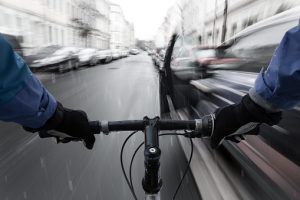
In Pennsylvania, biking can be a healthy form of exercise and a smart way to travel but all cycling comes with a certain level of risk. In order to avoid collisions, protect one’s self while on the road, and know when your rights have been infringed upon, it is important to be up-to-date on Pennsylvania’s bicycling laws.
A Bicycle is a Car?
The first, and most important, law to note is that in Pennsylvania, bicycles are considered to be a form of vehicle and that every person riding a bicycle on a roadway is subject to all of the rights and responsibilities applicable to the driver of an automotive vehicle (75 Pa. Cons. Stat. §§102 (2016)). Meaning, that while on a bicycle, you have the same rights as someone driving a car or truck and are subject to the same traffic laws. Therefore, cyclists must stop at stop signs and red lights, signal when turning and travel in the same direction as traffic.
Passing:
Motor vehicles are allowed to overtake bicycles but they must maintain a distance of four feet from the cyclist when doing so at a careful and judicious speed. Maintaining this four-foot distance is the responsibility of the motorist, not that of the cyclist. Motor vehicles may also overtake bicycles in a no-passing zone in order to avoid excessive delays, but, this must be done with care while maintaining a four-foot distance.
The same amount caution must be taken when moving back in front of a bicycle after passing so as not to cut off the cyclist and cause a collision. Motor vehicles must also exercise caution when parked and opening doors. The door to a motor vehicle can only be opened four feet from the path of a cyclist. Cyclists should also keep at least a four-foot distance when traveling alongside parked cars so as to avoid being “doored,” which can cause serious injury.
Where Can I Ride?
Bicycles are allowed on sidewalks in Pennsylvania but pedestrians have the right-of-way on both sidewalks and bicycle paths. In order to pass a pedestrian, cyclists must give an audible signal as they approach. In addition, there are certain instances when bikes are not allowed on sidewalks. These instances include busy business districts and when there are bicycle-only lanes present. The parking of a bicycle is allowed on a sidewalk and at the curb or edge of the road as long as the bike does not block pedestrian traffic or other vehicles.
While travelling the same direction as the flow of traffic in the street, it is recommended that cyclists ride close to or on the shoulder of the road; however, this is not required by law. Bicyclists in PA may also ride on the right half of the roadway on two-lane roads and in the right travel lane on multi-lane roads. Cyclists may move from the right-hand side of the road when overtaking another vehicle travelling in the same direction, when preparing to make a left turn, and when an obstruction exists that makes it necessary to change lanes or cross the centerline. In addition to these right-side rules, cyclists cannot ride more than two abreast unless paths or lanes are set aside for the exclusive use of bicycles. It should be noted that changing position in a lane quickly can cause an accident. Cars should always be conscious of cyclists, but the same goes for riders when they know they will need to move over.
Equipment:
Helmets are encouraged but not required in the Commonwealth of Pennsylvania for anyone over the age of 12. If you are not wearing a helmet, it cannot be used against you in a civil suit and you cannot be considered to be contributorily negligent. For those younger than 12, a helmet must be worn when riding a bicycle! This applies for children riding as passengers or riding in attached seats or trailers.
If you are riding a bike between sunset and sunrise, it must be equipped with a front lamp and both rear and side reflectors that are visible from at least 500 feet. In addition, the use of bells or horns is required in certain PA municipalities.
Earphones and headphones are prohibited. No one shall ride a bicycle “while wearing or using one or more headphones or earphones” (75 Pa. Cons. Stat. §§ 3314). While there is a lot of controversy over this point, the basic logic behind the law is that by using headphones, cyclists cannot safely hear the calls of other cyclists or the approach of passing cars. In order to ride safely you must be able to use all of your senses unobscured.
Takeaways:
To allow bicycling to be a fun and convenient means of transportation both drivers and cyclists must adhere to the rules of the road. While on a bike, cyclists should act in a predictable manner with no weaving or running traffic lights. Cars should also then allow bikes the proper amount of space and respect they are due. A failure to adhere to proper safety laws on either operator’s part could result in an irreparable accident.

